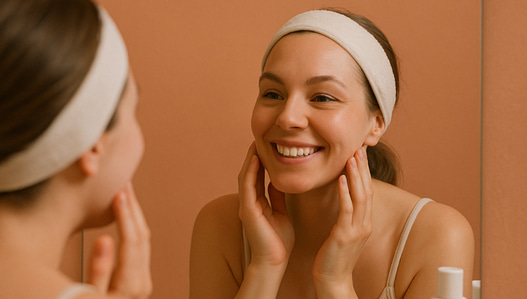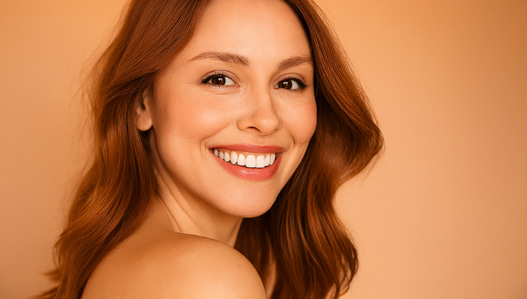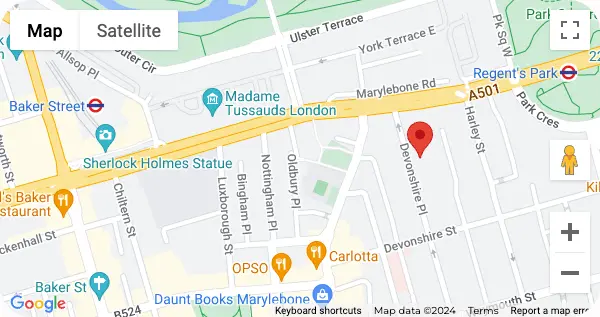Summary
Microneedling supports clearer skin by gentle exfoliation, pore tightening, and effective absorption of active skincare ingredients. It does not remove blackheads on the spot, but you will see the best improvement when you use it with a well-planned skincare treatment guided by a skin professional.
Introduction
Blackheads are stubborn tiny, dark spots that tend to return when you think they are gone. Many people in the UK turn to microneedling to help with clogged pores and rough texture.
Microneedling helps in smoothening the skin, tightening large pores, and improving overall skin quality. Making the skin stronger can make blackheads form less often. This guide breaks down how it helps, who might benefit, and how to use it safely in your routine.
What Are Blackheads?
Blackheads, also called open comedones, happen when pores get blocked with oil, dead skin, and dirt. Because the pore stays open, it is exposed to air and becomes dark, creating that familiar black spot. They usually appear on the nose, chin, and forehead, but it can also appear anywhere you have oil-producing glands.
Common Causes
- Too much oil (sebum): Hormonal changes, stress, or naturally oily skin can increase oil production that can easily fill the pores.
- Dead skin build-up: Old skin that stays on the surface is sometimes mixed with oil that results in clogged pores.
- Large pores: Some people naturally have bigger pores, others develop them because of ageing. Bigger pores trap more oil and dirt.
- Hormonal changes: Puberty, menstrual cycles, pregnancy, and stress can all increase oil production that makes blackhead more likely.
If you know what are the causes of blackheads, you can manage these triggers alongside microneedling treatment.
The Role of Microneedling Treatment
What is Microneedling?
Microneedling is a professional treatment that uses a device with tiny, sterile needles to make small, controlled punctures in the skin. These tiny micro-injuries trigger the skin’s natural healing process, increasing collagen and elastin production, the proteins that make the skin elastic, smooth, and healthy.
Related read: 5 Things You Should Know To Identify How Long Your Microneedling Session Takes
How Does it Work?
- Stimulates skin renewal: The tiny injuries help the skin to shed dead skin faster, which can lessen the buildup that may later lead to blackheads.
- Tightens pores with collagen: Collagen tightens and firms the skin and makes pores look smaller.
- Improves skincare absorption: After microneedling, your skin can absorb active ingredients like salicylic acid or retinoids more effectively.
- Support overall skin health: The treatment strengthens the skin barrier, balanced oil production, and improves texture over time.
Microneedling is considered safe when done by a trained professional and offers benefits that go beyond just helping with pores.
Related read: The Ultimate Guide to Post Microneedling Care: How to Achieve Flawless Skin
Does Microneedling Help with Blackheads?
Microneedling can make a real difference over time in improving how your skin works and in preventing new clogs.
Why Microneedling Helps
- Gentle exfoliation: It encourages your skin to shed old skin cells and grow new ones, it also stops the old dead skin building up in pores.
- Pore tightening: Collagen makes pores look smaller because it firms the skin. Then pores are tighter, oil is less likely to get trapped.
- Better product absorption: After microneedling, BHAs and retinoids sink deeper into the skin, these products help reduce blackheads formation.
- Less inflammation: Healthier skin is less prone to clogging.
What Doctors Say
Dermatologists agree that microneedling is not a quick-extraction method used to remove blackheads. It is used as a support for long-term skin health and helps reduce blackheads over time.
Related read: How to Prepare for Microneedling: Expert UK Guide
Observed Benefits from Clients
People who use microneedling regularly notice:
- Skin looks more clear for 2 to 3 weeks
- SKin is smoother around the nose and cheeks
- Pores are tighter
- Skin is less oily
- Results are more consistent with repeated sessions
Microneedling is a maintenance tool for healthy skin, not just a one-time fix for blackheads.
Microneedling vs. Other Blackhead Removal Techniques
| Technique | How It Works | Strengths | Limitations | How It Pairs with Microneedling |
| Microneedling | Uses tiny needles to create micro-injuries that boost collagen to make skin healthy. |
|
|
Acts as the base treatment |
| Manual Extraction | A therapist removes blockages directly during a facial. |
|
|
Cleaning the face through facial treatment makes microneedling more effective. |
| Chemical Exfoliants (BHAs & Retinoids) | Acids dissolve oil inside the pores, while retinoids speed up cell turnover and prevent blockage. |
|
|
Microneedling helps these products work well and make them more effective. |
| Cleansers | Removes surface oil, sweat, and dirt. |
|
|
Helps keep the pores clean while microneedling works on long-term skin improvement. |
| Professional Facials (e.g., HydraFacial) | Uses tools and specialised serums to extract debris from pores |
|
|
Clearing pores, while microneedling improves long-term texture. |
How to Prevent Blackheads
Blackheads come back easily, and a simple routine can make a difference in preventing them.
Daily skincare Tips
- Cleanse twice a day: Use a gentle face wash in the morning and at night to remove oil and dirt without drying your skin.
- Use salicylic acid (BHA): Salicylic acids deep cleanse the pores and help clogs to form.
- Add a retinoid: Retinoids renew the skin faster and keep the pores clear.
- Choose non-comedogenic products: these products are gentle and meant to not block the pores.
- Hydrate properly: Use light and oil-free moisturiser.
Effective & professional doctor-led Microneedling at our central London clinic
Verified Before & After
Verified Before & After
Using Microneedling Safely (Home vs Professional)
At-home rollers
These devices have tiny needles that help your skin absorb your skincare products better. Always clean them before and after use and use them gently on your skin.
Professional microneedling
Clinics use deeper and controlled needles that help reduce your pore size. It also improves the texture of your skin. Treatment is spaced every 4 to 6 weeks.
Related read: Does Microneedling Hurt? What You Really Need To Know?
Safety, Considerations and Who Should Avoid It
Microneedling is generally safe when done properly, but it is not for everyone. The skin needs to be calm and healthy enough to handle the treatment.
Possible Side Effects
It is normal to see mild reactions after each session like:
- Redness
- Mild swelling
- Temporary sensitivity
These side effects fade within a few hours. The bigger risk is infection from using unsanitised tools or if the treatment is not done properly especially at home.
Who Should Avoid Microneedling
Microneedling is not recommended if you have:
- Active acne
- Rosacea
- Eczema
- Active skin infection
- Very sensitive or reactive skin
Microneedling will only make your skin worse if it is already inflamed. Consult your skin specialist before starting to use this treatment to make sure your skin will achieve optimal results.
Related read: Microneedling Rosacea: Redefine Skin Clarity & Confidence
Conclusion
Microneedling is not a blackhead remover treatment, but it can be an effective treatment for long-term skin health. It will tighten your pores, improve skin renewal, and help in better skincare absorption. Microneedling creates healthier skin where blackheads are less likely to form.
For long-lasting results, microneedling works best as part of a full skincare plan. When paired with gentle exfoliants, good cleansing habits, and professional care, it can help keep pores clearer and smooth out your skin texture.
FAQs
- Does microneedling remove blackheads immediately?
No. Immediate removal requires manual extraction or chemical exfoliants. Microneedling helps prevent future clogs.
- How often should I microneedle for blackheads?
Professional sessions every 4 to 6 weeks are common. Home rollers can be used weekly or bi-weekly depending on skin sensitivity.
- Can microneedling make blackheads worse?
It can be used over active acne or with unsterile tools. Proper technique and hygiene are essential.
- Which products should I use post-microneedling for blackhead control?
Gentle cleansers, light moisturisers, and BHAs (once irritation settles). Avoid harsh exfoliants immediately after treatment.
- Is microneedling safe for all skin types?
Most skin types benefit, but those with eczema, rosacea, or active acne should check with a professional first.
Reserve a microneedling appointment
One of our experts will be more than happy to answer any questions you have.
Book AppointmentCandace Dannenbaum
★★★★★
Super knowledgeable and lovely space
14th November 2025
Nepa Abul
★★★★★
I had a great treatment with Dr Omar, highly recommend Dr Omar.
18th November 2025
Cleo Brock-Abraham
★★★★★
Very professional and careful. Would see again.
19th November 2025









